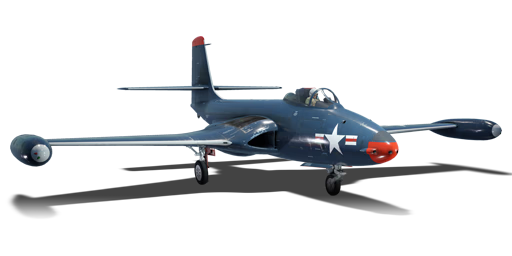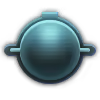



The Banshee first started life as the XFD-1 Phantom (not to be confused with the F-4 Phantom II) in the very late stages of World War 2. It was intended to be used during the planned invasion of Japan in 1946. A decent number of Phantoms were built, but they were quickly out of service when the far improved XF2D-1 Banshee was designed. It was more powerful and had more range thanks to its better engines and larger airframe. The F2H-2 Banshee was the second production variant of the Banshee. It had provisions for more fuel tanks and better engines than the F2H-1. The Westinghouse J34-WE-34 engine provided an 8% increase in thrust and allowed for more pylons to be added to the airframe. This would also be the most produced variant, with over 300 being built.
The F2H-2 was introduced in Update 1.45 "Steel Generals". The F2H-2 Banshee is a fantastic jet fighter with great overall speed and good manoeuvrability. The Banshee is a very stable platform at high speeds. With a structural speed limit of just under 1,000 km/h (621 mph), the Banshee can easily out-dive many early jet fighters. Furthermore, the Banshee comes armed with four chin-mounted 20 mm cannons, which are devastating to enemy aircraft with the air target belt. Overall, this jet is one of the best early US jets; its BR coupled with its very good performance make it a very pleasant aircraft to fly and grind the whole US air tree.
flaps
flaps
flaps
brake
| Belt | Belt filling | Armor penetration (mm) at a distance: | |||||
|---|---|---|---|---|---|---|---|
| 10 m | 100 m | 500 m | 1000 m | 1500 m | 2000 m | ||
| HEF-I/AP-T | 36 | 33 | 23 | 15 | 9 | 6 | |
| AP-T/AP-T/HEF-I/HEF-I | 36 | 33 | 23 | 15 | 9 | 6 | |
| HEF-I/HEF-I/HEF-I/AP-T | 36 | 33 | 23 | 15 | 9 | 6 | |
| AP-T/AP-T/AP-T/HEF-I | 36 | 33 | 23 | 15 | 9 | 6 | |
| HEF-I | 5 | 4 | 3 | 2 | 2 | 2 | |
| Name | Weight | Slot | ||||||||||
|---|---|---|---|---|---|---|---|---|---|---|---|---|
| Drop tank (200 gal.) | 100 kg |  |  | |||||||||
| 62.8 kg |  |  |  |  |  |  |  |  | ||||
| 117.9 kg |  |  |  |  | ||||||||
| 242.6 kg |  |  | ||||||||||












Flight performance | |
|---|---|
Survivability |
|---|
Weaponry | |
|---|---|